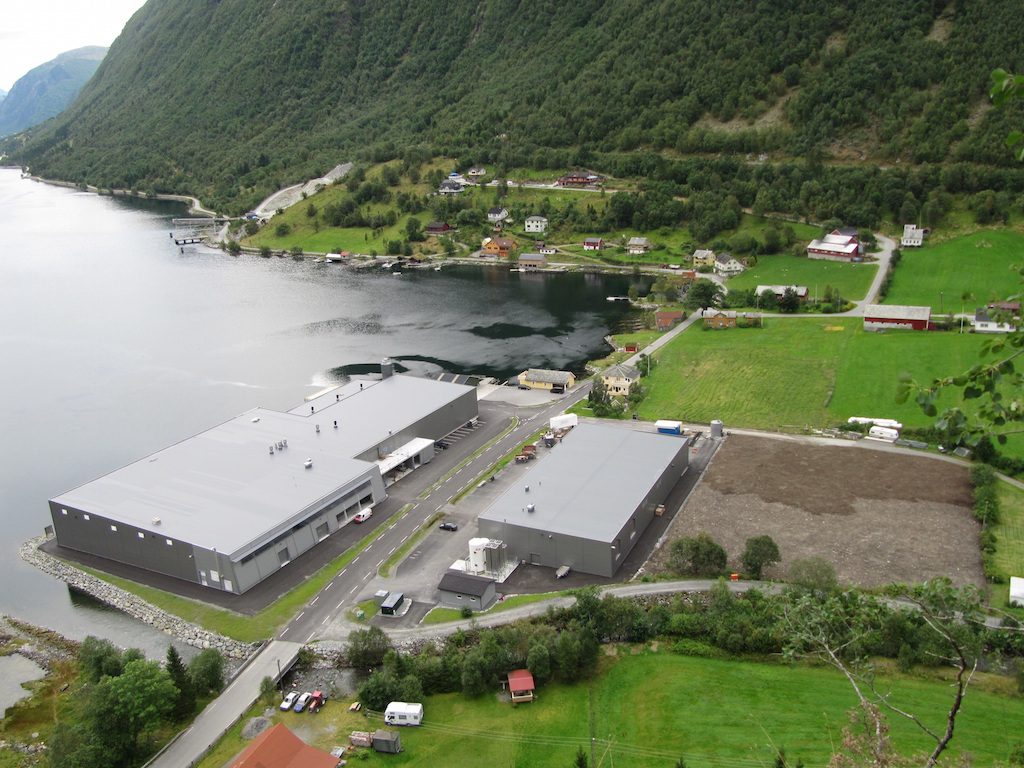
Features
Profiles
Marine Harvest’s hatchery scale-up
August 16, 2016 By William Stoichevski
 In western Norway Marine Harvest is quietly readying the official opening of the world’s largest recirc hatchery for salmon
In western Norway Marine Harvest is quietly readying the official opening of the world’s largest recirc hatchery for salmonAt Steinsvik, on the southern end of Dalsfjorden in western Norway, Marine Harvest’s regional freshwater manager, John-Ivar Saetre, enters the shiny new facility via an equipment bay.
The first random sight is of freshly sorted smolts of about 65 grams swimming the current in
transparent tubes as they head for the hatchery’s growout tanks. Marine Harvest expects more space and better management will help them grow to an eventual 200 g.
“We’re seeing growth, but work is needed before we can see growth of 150 g to 200 g,” says the regional boss. Steinsvik, Saetre reveals, has already helped regional smolt sizes grow to 150 g from under 100 g. The concession allows for 1,300 tons of biomass per year, part of 19 million smolts produced in Marine Harvest’s Western Norway region by this hatchery and six other area facilities.
Bigger, smarter fish
More growth is the goal, as fry-swimming-trials, smolt-lice experiments and other studies of juveniles point to greater survival rates at sea for bigger, stronger, smarter fish. Moving farther out to sea, to the tougher conditions beyond Norway’s protected channels, is the stated aim of some integrated growers here. Plans are in the works, and new offshore pen designs akin to oil rigs seem to demand tougher smolts.
For now, Steinvik’s permit is to produce 7.7 million smolts, with just over 6.5 million already produced. It is hoped 2016’s cohort, now at 150 g, will be nearer 200 g by spring 2017. “We’re aiming for (those) smolt sizes before releasing (to grow-out pens),” Saetre confirms. Release sizes are based on “the good correlation between a bit more growth and better production” at sea, where costs and risk for an integrated company tend to drag on.
Scalable RAS
Standard food is dispensed to new automated feeders for fry and smolt. Tanks are standard. What’s different are the scalable RAS systems for egg-side and growout-side in separate buildings (the smaller for ova trays and first feeds; a large building for two growth stages and vaccinations).
“Capacity increases are mostly about length and width. RAS offers temperature and water-quality control for stable operations instead of being dependent on the river,” Saetre says, a nod to Norway’s conventional freshwater hatcheries. Veolia business unit Krüger Kaldnes has designed and delivered Steinvik’s RAS.
Increased capacity
“We’re building increased capacity for (Marine Harvest’s) western region. One site will feature bigger smolts. Other sites can focus on (roe production),” Saetre says, confirming again that 200 g is the goal due to “big changes in production at sea.”
Despite its ambitions, Steinsvik is a relaxed place. About 15 staff are “not 24/7” and mostly employed getting eggs to the eye-ova stage in ova racks (empty when we arrived). Workers live within “response-time” radius of a few kilometres and are called if needed by smart phone alerts from hatchery sensors.
The nuts & bolts
The hatchery consists of an Alvestad recirculation cabinet good for three million eggs and equipped with a KUBE water supply, filter and temperature control. The cabinet receives eyed-ova that hatch after a couple of weeks. Five or six weeks later, the juveniles are moved to start feeds (at 350 to 400 decigrams). Six octagonal tanks 7.5 m wide are heated by radiant ground heat and pumps and can keep fish of up to 5 g. Hatchery growout to 30 g starts in six octagonal tubs with their own RAS system before moving to the larger building across the street for more of the same: six tubs, each of 750 m3 and a RAS that can handle a bit of sea water.
While helping staff remove ammonia, nitrates and nitrites, the RAS interface also helps degas carbon dioxide and oxygenate. The concrete sump of Steinsvik’s bio-filter – its Veolia moving bed biofilm reactor, or MBBR – with its bacteria-grabbing silicon disks, is unique. Below the smolt tanks are giant, 9-metre-tall oxygen cones, one for each tank. “If the O2 tanks are below, then you only need one pump,” says Saetre.
The freshwater management system’s interface in the control room monitors PH levels and circulation (also checked from an onsite water lab). Calcium is added “due to (biological) processes.” Fish densities are controlled (to a max. 75 kg per m3) as per the plant’s production certificate. Finally, utraviolet sterilization is applied to the inlet water only and not in the circulation system. The bio-filter’s sumps remove any unwanted bacteria, and the RAS and filter clear waste by treating 235 m3 of water per minute.
Simulated winter
To “simulate” winter at sea, on land, temperatures are dropped briefly in the smolt tanks and then dropped again for five or six weeks. The lights will be out 12 hours a day before a 24-hr lights-out period. To slow metabolisms to January levels in June, a cooling pump will arrive at the hatchery in November 2016. It is understood that the pump will also circulate salt water from up-fjord to help smolt acclimatize while gaining their sea-release weight of 200g.
While the electrical bills of this 7,000 m2 facility remain secret, Saetre does show us an immaculate 1,900 kW emergency power generator with the footprint of a locomotive. Alone in its bay, the engine looks capable of also powering the 28,000-vaccinations-an-hour automatic unit on hand, another nod to scale.
Yet, as RAS systems proliferate, Steinsvik isn’t the only symbol of an industry scaling up. Marine Harvest broke ground this winter on a similar facility near Bergen to feed its southern growouts, and word is rivals are building something bigger in Norway’s near-arctic.
— William Stoichevski
Print this page





